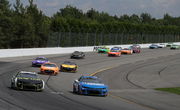
via Imago
April 18, 2022, Bristol, TN, United States of America: Ty Dillon races for position for the Food City Dirt Race at Bristol Motor Speedway in Bristol, TN. Bristol United States of America – ZUMAa161 20220418_zaa_a161_007 Copyright: xWalterxG.xArcexSr.x

via Imago
April 18, 2022, Bristol, TN, United States of America: Ty Dillon races for position for the Food City Dirt Race at Bristol Motor Speedway in Bristol, TN. Bristol United States of America – ZUMAa161 20220418_zaa_a161_007 Copyright: xWalterxG.xArcexSr.x
There is no denying the fact that in the current driver’s roster, it is Kyle Larson and Christopher Bell who equally dominate the world of stock car racing and sprint car racing. Both drivers are the winners of Chili Bowl Nationals and a plethora of dirt racing series. However, both drivers were intimidated by the daunting conditions of Bristol’s dirt track. They even endorsed the idea of eliminating the dirt track from the 2024 Cup Series.
However, before this iconic track was part of a never-ending debate, about whether it was a wise option to host a dirt race on the high-banked track of Bristol, one has to turn back the pages of NASCAR’s history to remember another controversial dirt track of NASCAR. The track had witnessed a series of fatalities before finally losing its stature and being lost in the pages of history. This track is none other than one of the iconic long tracks of NASCAR- Memphis Arkansas Speedway.
ADVERTISEMENT
Article continues below this ad
Reminiscing the iconic dirt-racing track that preceded the Bristol Dirt Race
Racing on a dirt track at the speed of 180mph not only requires racing prowess but also various other favorable factors for the smooth functioning of the race. However, the Bristol Dirt Race proved to be an utter nightmare for a majority of the drivers, as the track proved to be a wreck carnage. As a result, dirt racing prodigies like Larson had stated their disappointment at racing on dirt tracks.
Although the Bristol Dirt Track did not record any cases of fatality in its short span, the dirt track which was nothing more than a death trap for the drivers was Memphis-Arkansas Speedway. The 1.5-mile paperclip oval was constructed back in 1954 and boasted high banking and long straightaways. The track was originally meant to be paved, but would cost $100,000. However, due to the lack of funds, the owners of the track decided to transform it into a dirt track and opened its doors to the audience on October 7, 1954. And is still considered the longest dirt track in NASCAR’s premier series.
In the first event on the track, Lee Petty dominated the track but was unable to record a victory due to a broken axle, and Bud Baker notched the win. Reminiscing about the experiences of racing on the track, Richard Petty stated, “I remember going there a long time ago. We raced there in the summer and I went with Daddy. The track had a lot of banking, and I remember that they had two ponds on both ends of the speedway. They used that dirt for the banking.”
While the inaugural race was able to avert the ‘Big One’, tragedy struck on both days of the third Grand National in 1956. The track recorded some of the highest skewing to 100mph. However, these speeds were more often than not considered unmanageable and resulted in tragic events. One such driver being Tiny Lund, who was ejected from his #55 Chevrolet but was able to escape a major disaster with a broken arm. The reason behind the disaster was the broken seat-supplier belt.
It was not long before two other tragedies struck the drivers and claimed their lives in a single weekend. One being Clint McHugh, who rolled over in Turn 3 broke through the 3-foot flimsy guardrails, and plunged into a lake fifty feet below the banking. McHugh incurred heavy injuries and finally succumbed to it. The other incident that put the future of the track in jeopardy was the demise of Thomas “Cotton” Priddy. The driver rolled end-over-end and suffered serious injuries before breathing his last.
Watch this Story: Gentleman’s rule in NASCAR – The lost way of drivers self-policing
ADVERTISEMENT
Article continues below this ad
Trending
A dirt track that supports farming: the conclusion of Memphis-Arkansas Dirt Track
The future of the Memphis-Arkansas came to a standstill after the 1957 season. The dirt track proved to be a tough nut to crack for the drivers owing to the heavy cars and blinding dirt storms. Moreover, the owners Clarence Camp, Harold Woolridge, and Nat Epstein were unable to financially support the facility.
As a result, the track was sold to a local farmer, Clayton Eubanks Sr in 1958. The track was later transformed to breed catfish in the flooded infield. Later, the track was leveled to grow rice and soybeans. Speaking on the location of the track, the new track owner commented, “If the interstate would have been complete, it’s only a mile from Lehi to the off-ramp. They could have gotten onto the interstate and it would have been great.”
ADVERTISEMENT
Article continues below this ad
The original track layout no longer exists. But one can find traces of the track on Google Maps, which traces the curved landscape. Nevertheless, this track has been one of a kind in the 75-year history of NASCAR.
ADVERTISEMENT
ADVERTISEMENT
ADVERTISEMENT
ADVERTISEMENT






